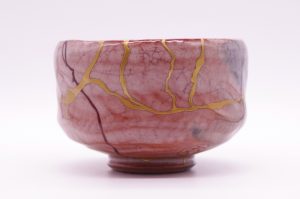
- ARAB NEWS
- 06 Jul 2025

Nader Sammouri
OSAKA: Breaks, blows, collisions and shattering are all parts of the imperfect human life. Avoiding something so inevitable to human nature could be exhausting, leaving those who strive for flawlessness disillusioned.
That is why finding beauty in imperfection is a worthy topic. One of the most elegant representations of it is Kintsugi, the traditional Japanese restoration technique that heals vessels and restores broken pottery with seams of pure gold that highlight its “flaws” rather than hiding them.

Kintsugi is a sustainable art that recycles discarded vessels. It dates back to the 15th century with the establishment of the tea ceremony. “Kin” means gold, and “tsugi” means joining. Together, it means “joining with gold” or “golden joinery.” Kintsugi ascended as a consequence of the Japanese belief that a life force resides in all creations, which promoted extraordinary care and attention to things. It is also related to the Wabi-Sabi (侘寂) aesthetic which sees beauty in incompleteness.

Authentic Kintsugi requires lots of patience. Nevertheless, the process of applying lacquer and completing a vessel empties the mind. Focusing on the vessel has a healing effect. Restoring pottery restores the self, as a therapeutic transformation occurs not just to the vessel, but to the person fixing it as well.
“It takes around a month to complete one Kintsugi. Commercial Kintsugi uses petroleum-based materials such as adhesives. However, the traditional craft uses ‘Urushi’ or lacquer mixed with powdered metal,” said Nobuyasu Suginaka.
Suginaka is a Kintsugi artist who owns a workshop called “Soweido” in Shiga prefecture. He specializes in an unusual technique called “Kawaritsugi,” which uses numerous colors, patterns, and materials beyond gold. He is also a master of lacquer or “Urushi,” which is an adhesive used to link the broken pottery parts and fill in missing gaps whose pieces are lost.
After that application, it is sprinkled with pure gold, silver, or platinum. The lines on each bowl, cup, or jug are distinctive and thus give it sort of a unique DNA.
“The golden lines usually follow the gaps. There is no design applied to their arrangement, but the cracks and chips dictate the form of the golden seams,” Suginaka said.
Kintsugi is slowly losing its authenticity to more affordable commercial applications. Ken and Michie, called the Kintsugi couple, approached Suginaka through their consulting firm, Isono Revitalizing Office, which specializes in art, to help him along with other dying craft businesses in Japan revitalize their local business.
“We consider thin lines in vessels to be beautiful and we put lots of attention and focus to ensure the wholeness of the vessel after Kintsugi is applied. We usually check the slits by placing a light inside the vessel. The light reveals the cracks as it leaks through,” Michie said.
Ken added: “And we finally test it by tapping on it. The sound reveals if there are any flaws. If it is complete, the tapping sound will be lighter.”

Cracks can be unpredictable. They can range in shape and size, and the bigger the cracks, the more there will be gold, and the value of the vessel may increase due to that.
“Sometimes a gold leaf is applied, which is a thin sheet of gold that covers big cracks. Lacquer is then applied over it to add a shining surface,” Suginaka said.
Aside from the astounding aesthetical arrest that Kintsugi produces, it can guide the craftsmen into a “flow state,” which is close to the Japanese term “Mushin” that means the state of no-mind (無心), a state that is demonstrated in Zen practice by monks, meditators, artists and martial artists.
Moreover, Kintsugi is most impressive because of its link to broken people. People look at their cracks or life problems and ill-fated situations and overlook the opportunity to heal them with gold.
The world and its societies are filled with inescapable blows, from the last decade’s relative spike of displacement in the MENA region to Covid-19, or the frequent natural disasters in Japan. Instead of reminiscing over the missing pieces, it is more constructive to shift the perspective towards creating more of a Kintsugi society that stares at the gaps and fills them with gold. From there, innovation and creation can arise from unfortunate circumstances.
The bigger the cracks, the more there will be gold and the value of the vessel increases.